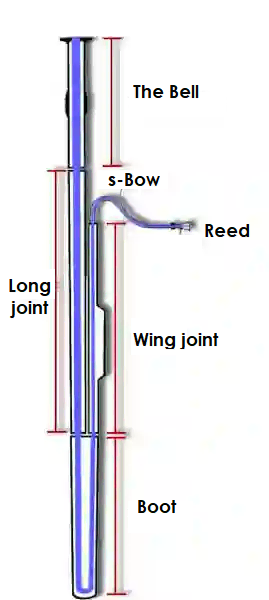Construction and function - Philipp Dangas
Construction and function
The modern bassoon is a tenor and bass woodwind instrument with a double reed . Its name (Italian fagotto = "bundle") derives from its multi-part design.
It consists of 2 adjacent wooden tubes, mostly made of maple wood. These are connected by a U-shaped drilled tube made in one piece (“boot”). The overall bore of the tube is conical (from 4 to 40 mm inner diameter).
The conical expansion runs from the mouthpiece to the sound hole. The total length of the reed, including the mouthpiece, is 2.59 m in the Heckel Bassoon. The instrument is shortened to 132-135 cm due to the U-shaped kinking of the reed. It consists of 5 individual parts
- 1.S-Bow
- narrow curved metal tube to which the double-reed mouthpiece is attached,
- 2.(small) wing joint
- the narrowest part of the pipe after the „S“
- 3.(butt)or boot
- which contains the U-shaped bend of the tube
- 4.(long joint) or bass joint,
- or also referred to as a bass rod which is fixed next to the wing in the boot (double hole).
- 5.(linters put on in B or A) The bell
The individual tube parts are attached to each other with metal rings. Today the bassoon is generally built according to the Almenräder-Heckel system . It has 21 to 22 keys and 5 open finger holes, namely 3 in the small wing and 2 in the boot piece.
The player holds this diagonally in front of him, tilting it up towards his left hand, with which he operates the upper keys and tone holes. The right hand operates the keys and tone holes on the boot piece. The instrument is held at its upper part by a strap placed around the player's neck.
Table summary of the functional principle of the woodwinds
Table with basic information on the functional principle of the woodwinds. Mouthpieces, reeds, tone holes and keys are briefly described. In addition, the term overblowing technique is examined under the magnifying glass.

The structure of the bassoon in large representation
The components of the bassoon
- The Bell
- s-Bow
- Long joint
- Reed
- Wing joint
- Boot
Internal search function
| Name | Value | Delete |
|---|